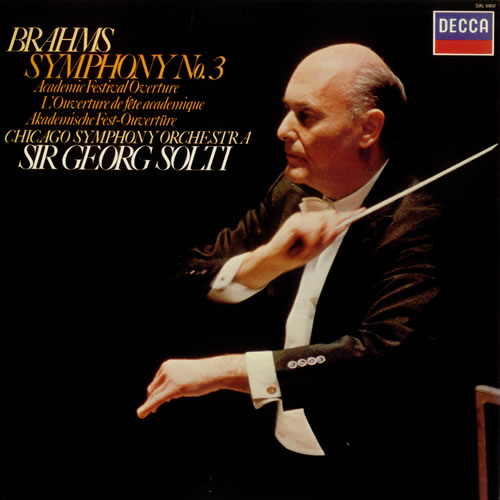Johannes Brahms (1833-1897)
Symphony No. 3 in F Major, Opus 90
Akademische Festouverture, Opus 80
Chicago Symphony Orchestra, Sir Georg Solti
Recording Location: Medinah Temple, Chicago, May 1978
ONE-SENTENCE REVIEW:
The greatest performance of the greatest Brahms symphony [best of 4] (and you can take that to the Medinah Temple!).
ORIGINAL LINER NOTES (English notes by Lionel Salter):
SYMPHONY NO. 3 IN F MAJOR, OPUS 90
When Brahms had written his First Symphony he was still unsure of himself as a writer for orchestra, and though respected as a musician, had still to make a reputation other than as a pianist and conductor.
By the age of 50, sever years later, this had all changed: established as a composer with the great success of his Second Symphony and Second Piano Concerto, and honored with doctorates from the universities of Cambridge (which he declined) and Breslau, Brahms was now internationally famous, and though he continued to give concert tours, these began to take second place.
In 1883, however, feeling the need for rest after strenuous concert activities, he went to Wiesbaden, where he completed the Third Symphony: it was performed on December 2 by the Vienna Philharmonic under Hans Richter (who had also introduced the Second).
Hanslick, Vienna’s leading critic, greeted the work thoughtfully and enthusiastically: “Many [music lovers] may prefer the titanic force of the First, others the untroubled charm of the Second… but the Third strikes me as artistically the most perfect. It is more compactly made, more transparent in detail, more plastic in the main themes; the orchestration is richer in novel and charming combinations; in ingenious modulations it is equal to the best of Brahms’ works.”
An allusion to Brahms‘ earlier days may be seen in the main subject of the first movement, which is rhythmically identical with that of the “Rhenish” Symphony by his friend and champion Schumann; but an even more meaningful retrospective glance is provided by the work’s initial three chords, a thematic cell that permeates the entire symphony. This is a version – as it were, saddened by experience – of Brahms’ frequently-invoked youthful “life-motto” F-A-F (Frei aber Froh, “free but cheerful”), which had been a response to his erstwhile friend Joachim’s F-A-E (Frei aber einsam, “free but alone”), a figure that appears in bars 3 and 4 of the Andante.
The Brahms pattern’s false relation (F-A / A-flat-F) lends the whole work a major-minor ambiguity which is resolved only at the very end when, after a finale in which the symphony’s climactic dramatic conflict is centered, it returns with a kind of calm philosophical resignation. (All the movements, indeed, end quietly.)
ACADEMIC FESTIVAL OVERTURE, OPUS 80
In acknowledgement of the honorary doctorate conferred on him by Breslau in 1879, Brahms composed, the following summer, two works which he conducted in that city on January 4, 1881. One was the Tragic Overture, which had partly existed in draft for some time, the other, brand new, the Academic Festival Overture, a rollicking pot-pourri of student songs.
It begins mysteriously with an oblique reference to the popular Rokoczi March, proceeds via a drumroll to “We have built a stately house” (to which the students would have sung their own, unprintable, alternative words), “The father of the country” (on violins) and the freshmen’s initiation song “What comes from up there” (on bassoons), and finally erupts into a joyously full-throated version of the most famous of all student songs, “Gaudeamus igitur.”
TRACK LISTING:
- 1-4: Symphony No. 3 in F Major, Opus 90 [38:51]
- 5: Akademische Festouverture, Opus 80 [10:35]
FINAL THOUGHT:
Above is a bonus Bernstein live performance of the 3rd Symphony – just because it’s awesome and I would prefer to have live performances as opposed to just audio (the Solti audio music links are at the top).
 Emily Sachs – President – Manka Music Group (A division of Manka Bros. Studios – The World’s Largest Media Company)
Emily Sachs – President – Manka Music Group (A division of Manka Bros. Studios – The World’s Largest Media Company)





